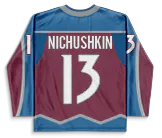Friedman will be the odd man out of the lineup on Tuesday as Carson Soucy (hand) makes his return to the lineup. Friedman played on Sunday, his first contest in three weeks, recording a -1 plus/minus, one shot, and one hit in 12:54 time-on-ice.

Friedman will be the odd man out of the lineup on Tuesday as Carson Soucy (hand) makes his return to the lineup. Friedman played on Sunday, his first contest in three weeks, recording a -1 plus/minus, one shot, and one hit in 12:54 time-on-ice.

The Stars acquired Tanev on Wednesday by giving up a 2024 second-round pick, a 2026 fourth-round pick, Artem Grushnikov and a conditional 2026 third-round pick to acquire Tanev. Tanev is a rugged defenseman, who has racked up 171 blocked shots this season to go along with one goal and 13 assists (14 points) in 56 games. He should bring plenty of stability to the Stars' second pairing. He has missed two games since joining the Stars due to immigration issues.

Nichushkin has not played since January 10th before entering the NHL's Player Assistance program. He has missed 19 games and, after returning to practice last week, appears ready to rejoin the Avalanche on Wednesday but has stated he is still undecided on his return. Before his absence, Nichushkin was scoring at a torrid pace with 21 points (19G / 9A) in his last 15 games.

Kovacevic has played four straight for the Canadiens but will be a healthy scratch on Tuesday. In those four games, Kovacevic recorded one assist, a +4 plus/minus, and four hits.

Nate Schmidt is battling an illness that will keep him out of the lineup on Tuesday, allowing Stanely to play for the second time in the last three games. The 25-year-old Stanely has played 13 games with the Jets this season, tallying one assist, 17 hits, and 21 blocks.

Simon Nemec will likely be a healthy scratch on Tuesday, allowing Smith to draw back into the lineup. Smith did not play for the Devils last night but has been quietly productive from the blueline lately, scoring four points (2G / 2A) in his last six contests.

Brendan Smith will likely draw into the lineup on Tuesday if Nemec is a healthy scratch. Nemec played 16:18 time-on-ice last night and recorded two shots on goal. The Slovak defender has been held off the scoresheet in four straight games.

Oesterle will make his first appearance since January 25th as Dennis Gilbert draws out of the lineup. Oesterle has no goals and two assists in 21 games this season.

Gilbert will take a seat on Monday as Jordan Oesterle draws into the Flames' lineup for the first time since January 25th. Gilbert has one goal and six assists in 32 games this season.

Lycksell will be back in the Flyers' lineup on Monday after sitting out Saturday's game against the Senators. Nicolas Deslauriers will sit in his place.

Deslauriers will be the odd-man out on Monday as Olle Lycksell is set to draw into the lineup in his place. Deslauriers is yet to score a goal in 54 games this season.

Wennberg's name has circulated trade rumours recently, validated on Monday night with a healthy scratch. The 29-year-old Wennberg is an impending UFA and has seen his production dip in recent years. That said, he has three points (1G / 2A) and six shots on goal in his last three games.

Jarred Tinordi will draw back into the Blackhawks lineup on Monday, as Phillips will serve as a healthy scratch. Phillips played for only the third time in the last eight games on Saturday and registered a -2 plus/minus, one shot, and two hits in 14:53 time-on-ice.

Isaak Phillips will be a healthy scratch on Monday, allowing Tinordi to re-enter the Blackhawks lineup. The 32-year-old Tinordi has six points (0G / 6A), 114 hits, and 76 blocks in 37 games this season.

MacKenzie Entwistle will draw back into the lineup on Monday, sending Johnson to the press box as a healthy scratch. Johnson played the last five games for the Blackhawks, tallying one point (0G / 1A), a -2 plus/minus, 10 penalty minutes, and eight shots on goal.

Reese Johnson will be a healthy scratch on Monday, allowing Entwistle to re-enter the lineup. Entwistle scored on February 25th, his only one point in the last 32 games.

Josh Manson is battling a lower-body injury and will be replaced by Jones if he is not able to suit up. Jones has not played since January 15th, an 18-game stretch.

Nichushkin has not played since January 10th before entering the NHL's Player Assistance program. He has missed 18 games and, despite returning to practice last week, will miss at least one more as he reacclimates to the team and conditioning. Before his absence, Nichushkin was scoring at a torrid pace with 21 points (19G / 9A) in his last 15 games.

Dennis Gilbert will be a healthy scratch on Monday night, allowing Oesterle to play his first game since January 25th. In 21 games with the Flames this season, Oesterle has two points (0G / 2A), 20 hits, and 32 blocks.

Jordan Oesterle will play his first game in over a month, resulting in Gilbert being a healthy scratch against Seattle on Monday. Gilbert played his first game in a month on Saturday and was limited to only 9:13 time-on-ice, registering a -1 plus/minus and three hits.
